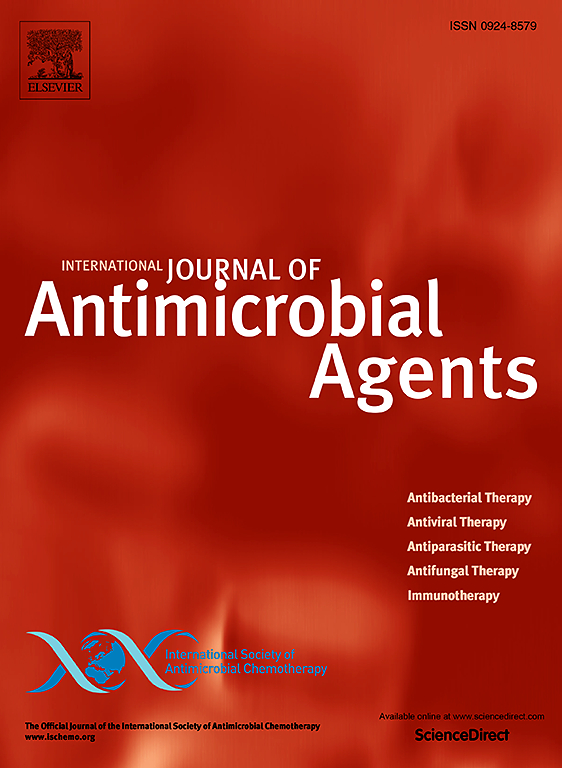亚胺培南-瑞巴坦、头孢唑嗪-他唑巴坦及比较物对引起血液学和肿瘤学患者严重感染的肠杆菌和铜绿假单胞菌临床分离株的活性:一项前瞻性多中心研究
IF 4.6
2区 医学
Q1 INFECTIOUS DISEASES
International Journal of Antimicrobial Agents
Pub Date : 2025-05-08
DOI:10.1016/j.ijantimicag.2025.107534
引用次数: 0
摘要
背景:关于抗微生物药物对引起肿瘤和血液学患者严重感染的分离株活性的研究很少。ceftolozan -tazobactam (TOL/TAZ)和亚胺培南-relebactam (IMP/REL)是抗多重耐药革兰氏阴性微生物的新型抗菌药物。我们评估这些抗菌剂和比较剂的体外活性对最近临床分离血液和肿瘤患者在西班牙。方法:55个中心参与了一项全国性的研究。从菌血症、下呼吸道感染(LRTIs)、并发泌尿系统感染(cUTI)和并发腹腔内感染(cIAIs)患者中前瞻性回收分离株。按照EUCAST指南研究TOL/TAZ、IMP/REL、亚胺培南(IMP)、美罗培南(MER)、头孢他啶(CAZ)、头孢吡肟(FEP)、哌拉西林-他唑巴坦(PIP/TAZ)、左氧氟沙星(LEV)、阿米卡星(AK)的活性。采用标准方法检测耐药机制。结果:共分离997株,其中肠杆菌(EB) 563株,铜绿假单胞菌(PA) 434株。EB/PA的来源为:菌血症(n=347/182)、LRT (n=51/139)、尿液(n=95/64)和腹腔内标本(n=70/49)。EB中TOL/TAZ、IMP/REL、MER、FEP、CAZ、PIP/TAZ、IMP、LEV、AK易感率分别为93.6%、98.9%、98.6%、87.4%、82.2%、93.6%、98.6%、73.7%、97.3%。PA的对应值分别为92.2%、90.1%、87.8%、81.9%、81.7%、75.7%、75.2%、63.3%、96.1%。14/17株(EB/PA)为碳青霉烯酶产生菌,82株EB为esbl产生菌。IMP/REL恢复了14.7%的IMP抗性PA的IMP活性。结论:TOL/TAZ和IMP/REL是抗PA活性最强的β -内酰胺类化合物。IMP/REL对EB的抑制作用最强;30%的分离株对左氧氟沙星耐药。本文章由计算机程序翻译,如有差异,请以英文原文为准。
Activity of imipenem-relebactam, ceftolozane-tazobactam and comparators against clinical isolates of Enterobacterales and Pseudomonas aeruginosa causing severe infections in hematological and oncological patients: A prospective multicenter study
Objectives
Studies regarding the activity of antimicrobials against isolates causing severe infections in oncological and hematological patients are scarce. Ceftolozane-tazobactam (TOL/TAZ) and imipenem-relebactam (IMP/REL) are among the new antimicrobials active against multiresistant gramnegative microorganisms. We evaluate the in vitro activity of these antimicrobials and comparators against recent clinical isolates from hematology and oncology patients in Spain.
Methods
A total of 55 centers participated in a nationwide study. The isolates were prospectively recovered from patients with bacteremia, lower respiratory tract infections (LRTIs), complicated urinary infections (cUTI), and complicated intra-abdominal infections (cIAIs). The activities of TOL/TAZ, IMP/REL, imipenem (IMP), meropenem (MER), ceftazidime (CAZ), cefepime (FEP), piperacillin-tazobactam (PIP/TAZ), levofloxacin (LEV), and amikacin (AK) were studied following the EUCAST guidelines. Resistance mechanisms were detected by standard methods.
Results
A total of 997 isolates (563 Enterobacterales (EB) and 434 Pseudomonas aeruginosa (PA)) were collected. The source of EB/PA were: bacteremia (n = 347/182), LRT (n = 51/139), urine (n = 95/64), and intraabdominal samples (n = 70/49). Among EB, 93.6%, 98.9%, 98.6%, 87.4%, 82.2%, 93.6%, 98.6%, 73.7%, and 97.3% were susceptible to TOL/TAZ, IMP/REL, MER, FEP, CAZ, PIP/TAZ, IMP, LEV, and AK, respectively. The corresponding values for PA were 92.2%, 90.1%, 87.8%, 81.9%, 81.7%, 75.7%, 75.2%, 63.3%, and 96.1%, respectively. A total of 14/17 isolates (EB/PA) were carbapenenase-producers, and 82 EB isolates were ESBL-producers. IMP/REL restored the activity of IMP in 14,7% of IMP-resistant PA.
Conclusions
TOL/TAZ and IMP/REL were the most active of the beta-lactams against PA. IMP/REL was the most active agent against EB; 30% of the isolates were resistant to levofloxacin.
求助全文
通过发布文献求助,成功后即可免费获取论文全文。
去求助
来源期刊
CiteScore
21.60
自引率
0.90%
发文量
176
审稿时长
36 days
期刊介绍:
The International Journal of Antimicrobial Agents is a peer-reviewed publication offering comprehensive and current reference information on the physical, pharmacological, in vitro, and clinical properties of individual antimicrobial agents, covering antiviral, antiparasitic, antibacterial, and antifungal agents. The journal not only communicates new trends and developments through authoritative review articles but also addresses the critical issue of antimicrobial resistance, both in hospital and community settings. Published content includes solicited reviews by leading experts and high-quality original research papers in the specified fields.

 求助内容:
求助内容: 应助结果提醒方式:
应助结果提醒方式:


